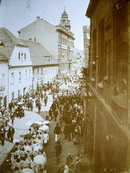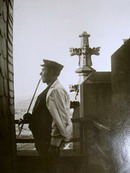 The first written references to Louny date back to the year 1115, at which time t was the property of the monastery in Kladruby. This Romanesque settlement covered the area of the modern-day Chapel of St. Peter (kostelik sv. Petra) by he ford that crosses the River Ohfe. As a royal town, Louny was hoisted up on 3 projection of land over the river perhaps 1 km to the east of the original settlement sometime around the 1260s under the rule of Premysl Otakar II. The town was Duilt on an oval ground plan with a rectangular square and a trio of long, linear streets. It was protected by town walls with bastions and two gateways - the Drague gateway and the Zatec gateway. A Dominican monastery was founded at the same time as the town, but this was destroyed during the Hussite Wars, fhe town prospered during the Lucemburk period, prosperity that was based on ntensive craft and agricultural production, in particular the cultivation of grain and grapes. Louny and Zatec formed a military alliance during the Hussite Wars. The district administrator during the Twenties was the celebrated warrior Jakoubek of Vfesovice. Louny took possession of large areas of land from the destroyed monastery, but was forced to return it under the reign of Jin of Podebrady. The town was then rebuilt following a destructive fire in 1517 and the new Church of St. Nicholas (kostel sv. Mikulase) was built. The local municipal school gained renown during the 16th century and winemaking blossomed. Louny stood on the side of the rebels during the anti-Habsburg resistance of 1618 to 1620. Indeed Albrecht of Valdstejn took control of the town shortly before the Battle of White Mountain, imposed a huge ransom on the town, and set up his main HQ here. Louny became a small town of only local importance following the Thirty-Year War. However, the three monarchs of the anti-Napoleonic coalition stayed here in the year 1813. Louny then became the seat of the district authority in the middle of the 19th century. The 19th century and the 1960s and 1970s saw the extensive demolition of the historic centre of the town. And so it was that a number of magnificent Renaissance buildings disappeared, as did the town hall and town gates. The economic development of Louny did not come about until the second half of the 19th century, at which time railway repair shops, a sugar factory, a brewery, abattoirs, mills, and financial institutes were all established. The first written references to Louny date back to the year 1115, at which time t was the property of the monastery in Kladruby. This Romanesque settlement covered the area of the modern-day Chapel of St. Peter (kostelik sv. Petra) by he ford that crosses the River Ohfe. As a royal town, Louny was hoisted up on 3 projection of land over the river perhaps 1 km to the east of the original settlement sometime around the 1260s under the rule of Premysl Otakar II. The town was Duilt on an oval ground plan with a rectangular square and a trio of long, linear streets. It was protected by town walls with bastions and two gateways - the Drague gateway and the Zatec gateway. A Dominican monastery was founded at the same time as the town, but this was destroyed during the Hussite Wars, fhe town prospered during the Lucemburk period, prosperity that was based on ntensive craft and agricultural production, in particular the cultivation of grain and grapes. Louny and Zatec formed a military alliance during the Hussite Wars. The district administrator during the Twenties was the celebrated warrior Jakoubek of Vfesovice. Louny took possession of large areas of land from the destroyed monastery, but was forced to return it under the reign of Jin of Podebrady. The town was then rebuilt following a destructive fire in 1517 and the new Church of St. Nicholas (kostel sv. Mikulase) was built. The local municipal school gained renown during the 16th century and winemaking blossomed. Louny stood on the side of the rebels during the anti-Habsburg resistance of 1618 to 1620. Indeed Albrecht of Valdstejn took control of the town shortly before the Battle of White Mountain, imposed a huge ransom on the town, and set up his main HQ here. Louny became a small town of only local importance following the Thirty-Year War. However, the three monarchs of the anti-Napoleonic coalition stayed here in the year 1813. Louny then became the seat of the district authority in the middle of the 19th century. The 19th century and the 1960s and 1970s saw the extensive demolition of the historic centre of the town. And so it was that a number of magnificent Renaissance buildings disappeared, as did the town hall and town gates. The economic development of Louny did not come about until the second half of the 19th century, at which time railway repair shops, a sugar factory, a brewery, abattoirs, mills, and financial institutes were all established.
 The first secondary school was then opened in 1896, the "realschule" (technical school), now known as the Vaclav Hlavaty Grammar School. Louny became a railway junction on the main routes to Prague, Most, Zatec, Libochovice, and Rakovnik between 1872 and 1904. The town then witnessed extensive construction of family homes at the turn of the 19th and 20th centuries. So it was that places which had once been home to agricultural land became residential zones. Industry in Louny received a further boost post-1945 with the foundation of the Elektroporcelan and Praga factories, a dairy, and a meat-processing plant. The suburb of Zatec was levelled during the 1970s and pre-fabricated housing estates erected in its place. Louny is a town that has always lain on the border in terms of language. For example, the town of Postoloprty 8 km to the west was German during the 18th century. However, the unambiguously Czech character of Louny has been maintained throughout its history. Louny became the seat of the district authority in the middle of the 19th century. The districts of Zatec and Podbofany were then added in 1960. One of the historic monuments to have been preserved in the town is the Church of St. Nicholas (kostel sv. Mikulase), one of the most prominent building monuments in Louny. Only the tower of the original Gothic structure from the 14th century has been preserved. The atrial triple-nave was built between 1519 and 1538.  The architect was Benedikt Rejt, who was later buried here in the church. His grave does not remain intact. Other religious structures of note include the Church of St. Peter (kostel sv. Petra) from the 14th century, the Church of Our Lady (kostel Matky Bozi) from 1493 (tower built in 1612), and the Church of the 14 Holy Helpers (kostel 14 sv. pomocniku) from 1716. Meanwhile, the churches of the Bohemian Brethren and Czechoslovak Hussite Church are important monuments from the 1930s. Among the medieval buildings to have been preserved is the building at number 57 on Mirove Square, with its Renaissance escutcheons and cobwork hall on the first floor, the home of the district archive. Meanwhile, a late-Gothic hall with rib vaulting remains intact at number 43 Pivovarska Street. This building is now used as exhibition space for the district museum. The neo-Renaissance town hall on Mirove Square dates back to 1887. The colony of structures designed by Jan Kotera and built for the employees of the railway repair shops at the beginning of the 20th century has found a place for itself in the history of modern architecture in the town. The jneart of the town in embraced by a belt of town walls with bastions and the Zatec gateway. The Louny fortifications of today are the result of gradual reconstruction work that took place in the second half of the 15th century. The architect was Benedikt Rejt, who was later buried here in the church. His grave does not remain intact. Other religious structures of note include the Church of St. Peter (kostel sv. Petra) from the 14th century, the Church of Our Lady (kostel Matky Bozi) from 1493 (tower built in 1612), and the Church of the 14 Holy Helpers (kostel 14 sv. pomocniku) from 1716. Meanwhile, the churches of the Bohemian Brethren and Czechoslovak Hussite Church are important monuments from the 1930s. Among the medieval buildings to have been preserved is the building at number 57 on Mirove Square, with its Renaissance escutcheons and cobwork hall on the first floor, the home of the district archive. Meanwhile, a late-Gothic hall with rib vaulting remains intact at number 43 Pivovarska Street. This building is now used as exhibition space for the district museum. The neo-Renaissance town hall on Mirove Square dates back to 1887. The colony of structures designed by Jan Kotera and built for the employees of the railway repair shops at the beginning of the 20th century has found a place for itself in the history of modern architecture in the town. The jneart of the town in embraced by a belt of town walls with bastions and the Zatec gateway. The Louny fortifications of today are the result of gradual reconstruction work that took place in the second half of the 15th century.
Louny also has much to offer in the way of sporting and cultural entertainment. For example, the town is home to an outdoor pool, an ice rink, a sports hall, and the newly reconstructed Vrchlicky Theatre (Vrchlickeho divadlo). Meanwhile, the nearby Rana Hill is a well-known spot for paragliding and hang-gliding enthusiasts. The expansive park by the river is often the site of shopping fairs. The exhibition centre is now part of the town relaxation zone, the main purpose of which is to organise shopping and exhibition events and to arrange cultural, social, and sporting events. The centre in Louny is the only permanent exhibition complex in the Chomutov, Louny, and Most regions.
|